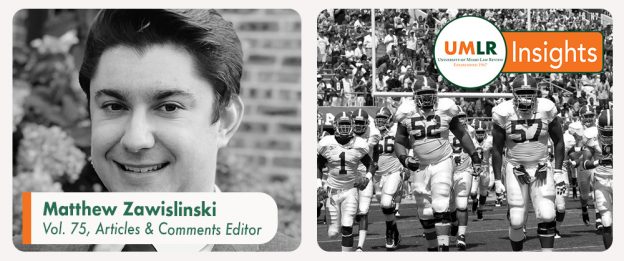MATTHEW ZAWISLINSKI—Life is getting harder and harder for the NCAA these days. With attacks coming from sports media personalities and state legislatures, the NCAA is facing more threats than ever before. While its name, image, and likeness rules have received substantial scrutiny in the last year, the NCAA’s gravest concern should be attacks on its amateurism model that might lead to litigation and subsequent court invalidation of many NCAA bylaws. Amateurism is the underlying principle that the NCAA uses to limit overall student-athlete compensation. Ultimately, the NCAA limits student-athlete compensation because they believe college sports’ popularity stems from the difference between college and professional sports, namely that student-athletes are not paid.
In NCAA v. Board of Regents, decided in 1984, the Supreme Court discussed amateurism at length and made multiple noteworthy observations. Specifically, the Court stated that college sports’ “academic tradition” contributed to the NCAA’s popularity and that to sustain college football’s quality, “athletes must not be paid, must be required to attend class, and the like.” The Court also noted that amateurism is a “revered tradition” in college sports and that the NCAA has the power to oversee the role that the student-athlete has in college athletics. In the thirty years following Regents, the NCAA used this language like as an endless gold mine, creating an air of infallibility around its amateurism principle. Until recently, the amateurism language from Regents went unchallenged, and the amateurism principle has successfully stood in the way of meaningful change to NCAA rules.
The tide began to turn in 2015 when a case about limited v. unlimited scholarship benefits for student-athletes reached the Ninth Circuit Court of Appeals. In O’Bannon v. NCAA, student-athletes argued that their scholarships were impermissibly limited to things like tuition and books but did not cover the full living expenses (cost of attendance) at universities. Student-athletes claimed that this cap was an anti-trust violation and that the cap should increase to the full cost of attendance, which would result in thousands of dollars in increased scholarship per student-athlete. The Ninth Circuit accepted the student-athletes’ argument and held that certain NCAA amateurism rules violated antitrust law. But the most important language from O’Bannon referenced Regents and the Supreme Court’s amateurism discussion. The Ninth Circuit stated that while the Supreme Court spoke about NCAA amateurism rules in detail in Regents, NCAA rules’ legality was not an issue presented to the Court in Regents. Thus, the Ninth Circuit found that the Court’s amateurism discussion was entirely dicta and the NCAA’s amateurism rules were not “categorically consistent” with antitrust law. The Ninth Circuit’s explanation opened the door for more challenges to NCAA rules and amateurism as a justification for limiting student-athlete benefits.
In 2016, student-athletes sprinted through that opening and challenged NCAA compensation rules again. In In re: NCAA Grant-in-Aid Cap Antitrust Litigation, student-athletes argued that instead of capping benefits at cost of attendance, the NCAA should allow unlimited education related benefits. Again, the NCAA argued that unlimited education benefits would lead to uncontrolled compensation, blur the lines between professional and collegiate sports, and decrease consumer demand for collegiate sports. The heart of the NCAA’s argument was that increased benefits will make student-athletes look like professionals instead of amateurs and that the public’s perception of amateurism is primarily responsible for the NCAA’s popularity. However, in NCAA Grant-in-Aid, the district court found that while amateurism has some effect on the NCAA’s popularity, it was not a strong enough defense to prevent unlimited education related benefits. The NCAA appealed this decision, and oral argument is scheduled for March 2020. On appeal is whether amateurism has any positive impact on consumer demand for college sports and whether amateurism is a valid justification to ban unlimited education related benefits.
The Ninth Circuit faces a big decision about amateurism’s continued viability to halt change to NCAA rules. In O’Bannon, the Ninth Circuit dipped one toe into a world uncontrolled by the amateurism principle but did so where the amount of benefits at issue were minimal. In NCAA Grant-in-Aid, where hundreds of thousands of dollars per student might be at issue, we will see if the Ninth Circuit deals a major blow to amateurism or retreats to the dark ages controlled by Regents.






